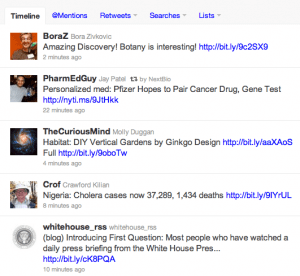

Blogging and podcasting are not the only forms of social media that I have found useful for teaching and research. I use Twitter to locate or disseminate information about virology. I often tweet when I write a new blog post or release a podcast, or when I find an article of interest. You can see what I post on Twitter without ever visiting the site – my most recent tweets are listed on virology blog, in the lower right hand column. The individuals who follow me on Twitter can investigate further by clicking on the links that I provide in each tweet.
For me the value of Twitter lies in the individuals that I follow – mainly scientists and science writers. You must be judicious in selecting who to follow, otherwise your Twitter stream will be too dense. I have found that following 100-200 individuals provides just the right amount of information. Unfortunately, there are few microbiologists on Twitter, and even fewer virologists. And the science writers far outnumber the scientists. I do not see this situation changing in the near future, so I conclude that for me Twitter is more about giving than receiving.
Another service that I find very useful is FriendFeed. This site provides a means for aggregating all of my online activities – tweets, blog posts, podcasts, YouTube videos, to name just a few. My followers can then see everything I do online at one site. In turn, I can follow others and track their online activities. An advantage of FriendFeed is that you can comment, like, or share any item, a feature can be useful for scientific discussions. For example, I can post links to interesting journal articles, and if my followers are interested they can begin a discourse on each one.
Then there is Facebook (which recently acquired FriendFeed). The sheer number of people there make it impossible to ignore. For example, I started a virology group on Facebook over a year ago, and even though I did not publicize it, 417 individuals joined. I just started a Facebook page for my podcast ‘This Week in Virology’, where I will post news about TWiV, and which I hope will become a gathering place for people who want to learn more about viruses. You can find it here.
Racaniello VR (2010). Social media and microbiology education. PLoS pathogens, 6 (10) PMID: 20975949
